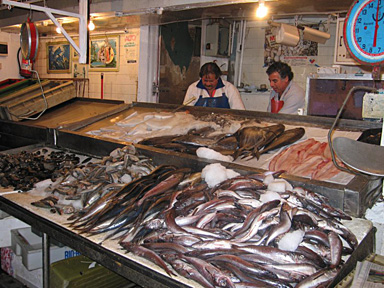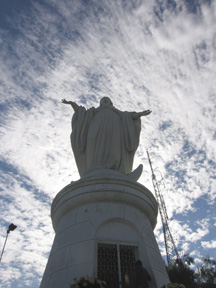| |
| |
|
|
|
|
| |
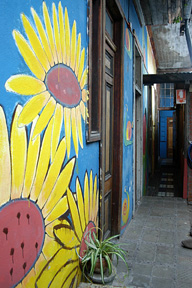 |
|
I was glad to be back in Santiago. Ten days earlier, my daughter, Molly, and I had spent part of a smoggy day in Chile’s capital city before my flight to Puerto Natales and travels in Patagonia. We had overnighted in a funky hostel in the Barrio Brazil. The hostel was a colorful phantasm of yellows, reds, blues, oranges and lime. Our room was about eight feed wide and fifteen feet deep. Earlier that day we met one of Molly's Chilean friends for lunch at a trendy cafe, where an older man solicitously romanced a younger woman, groups of college-aged girls giggled, and young sophisticates waved lighted cigarettes while animatedly discussing politics. Outside we passed by street-side jugglers and garbage men waxing poetic. We toured the town as Molly checked out potential hostels for future visits. We passed the Palacio de la Moneda, Chile’s presidential palace. On September 11, 1973, a military coup led by General Augusto Pinochet had invaded the capital city. Tanks rumbled into the Plaza de la Constituction, the public plaza that fronts the palace. Airplanes bombed the palace, destroying much of its interior. Depending on which version is believed, deposed President Salvador Allende killed himself or was murdered. |
|
| |
A colorful phantasm |
|
|
|
| |
|
|
| |
When the shuttle driver dropped me off, I quickly recognized the Hotel Plaza Londres from my walk with Molly. It’s located in the Barrio Paris-Londres, a neighborhood with cobblestone streets just off Santiago’s main thoroughfare, the Avenida Libertador General Bernardo O’Higgins, better known as The Alameda. After checking in, I checked out downtown. I meandered through outdoor markets and enjoyed the city’s bustling, cosmopolitan atmosphere. The streets were alive with professionally outfitted men and women leaving work. Most were hustling to Metro subway cars or patiently waiting in orderly lines for buses. Street beggars rattled cups hoping for change. One woman handed an elderly crone an empanada. Couples huddled in corners or on park benches, cuddling, kissing and fondling. In the evening light, the Cathedral San Francisco, a red-washed colonial church, glowed majestically. Remembering how delicious the empanada looked and smelled, I bought some for myself before returning to my room and plotting my next day’s plans. |
|
| |
|
|
| |
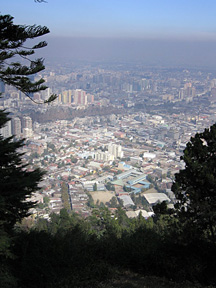 |
|
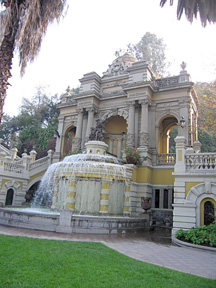 |
|
| |
Santiago's skyline |
|
Fountain along the Alameda |
|
| |
|
|
| |
Santiago, a city with more than five million people, is known for its pervasive air pollution. Many days, vistas are shrouded by murky gray smog. So when I awoke the following morning and the view out my fourth floor window was bluebird sunny, I moved fast. Within minutes I’d eaten breakfast, deposited my pack at the front desk and strolled along the Alameda to Cerro San Cristobal. At its base of the hill are fountains, ornate facades, monuments and swirling stairways that lead up and up, offering sweeping views of the city. The smog had cleared so the distant panorama included the snow-tipped Andes, Chilean Coastal Range and Cordon de Chacabuco, a transverse mountain range of the Andes.
Over the next several hours, I savored Santiago. |
|
| |
|
|
| |
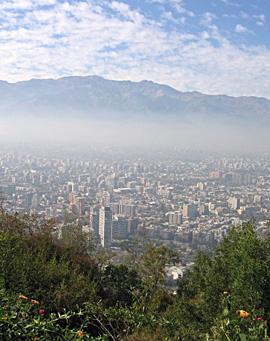 |
|
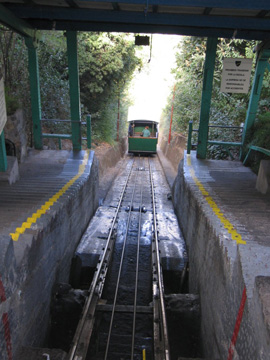 |
|
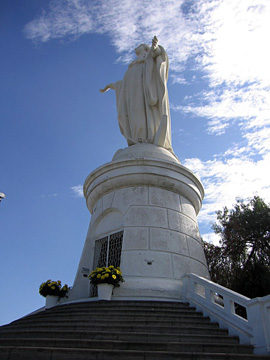 |
|
| |
Mountains surround Santiago |
|
The hill-climbing funicular |
|
The 46-foot tall virgin |
|
| |
|
|
|
|
|
|
| |
I hiked partway up Cerro San Cristobal to the zoo, where I boarded a funicular, an inclined railway, at its mid-point station. It clumbered up the hill and unloaded at the summit where it was just a short walk to a church and, more dazzling, the welcoming, out-stretched arms of the Virgen de la Imaculade, a towering statue of the Virgin Mary. It was from here in 1987 that Pope John II said mass to hundreds of thousands of Santiaguinos. From the hilltop, paths wove around past swimming pools and through gardens and the forested Parque Metropolitano, Santiago's largest public park. |
|
| |
|
|
| |
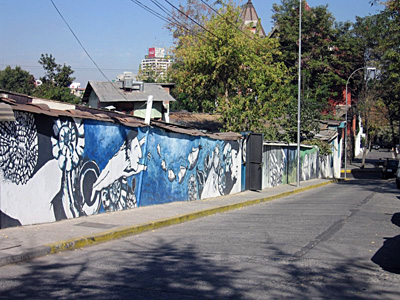 |
|
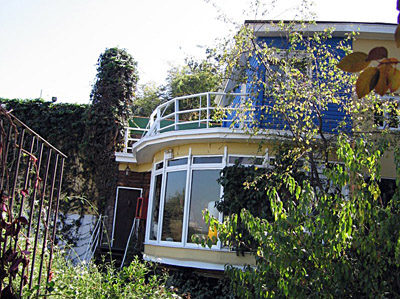 |
|
| |
Colorful Bellavista |
|
Pablo Neruda's La Chascona |
|
| |
|
|
| |
It was an easy downhill walk to Bellavista, the city’s artsy bohemian district. A winding street leads to La Chascona, the home of Pablo Neruda, the larger-than-life Nobel Prize winning poet who died in 1973 shortly after the military coup. I joined an English speaking guide for an hour-long tour of the fascinating home Neruda built in 1953. Its name, La Chascona, the "Uncombed" or the "Woman with Tousled Hair," refers to Matilde Urrutia, Neruda's secret lover until she became his third wife. Touring the weirdly designed house is like stepping into Neruda's singular mind. La Chascona and his other eclectic homes earned him the moniker, organic architect. Inside are odds bodkin collections of butterflies, seashells, paintings and wine glasses. The house has a library, secret passageway and tower bedroom. Outside are paths that meander through gardens and terraces and across bridges. |
|
| |
|
|
|
|
| |
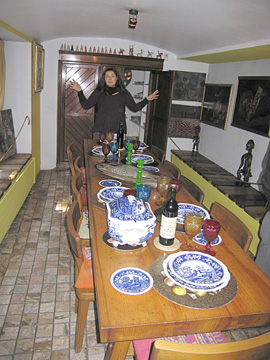 |
|
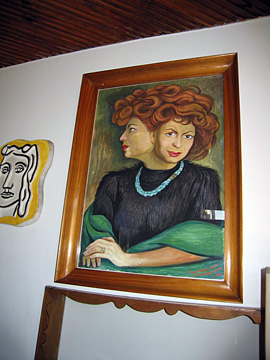 |
|
| |
Inside La Chascona |
|
Matilde Urrutia "Uncombed" |
|
| |
|
|
|
|
| |
Having worked up a ferocious hunger, I returned to the central city following the Mapocho River and the Parque Forestal past the Museo de Bellas Artes to the Mercado Central.
|
|
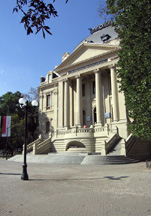 |
|
| |
|
|
Museo de Bellas Artes |
|
| |
|
|
| |
The seafood market is known for its bustling atmosphere and side-by-stalls offering salmon, sea bass and fish I’d never seen, plus a bouillabaisse variety of clams, oysters, shrimp, prawns, urchins, scallops, squid, octupus, craf and mussels. The market is also filled with restaurants. Like barkers normally seen outside strip clubs, fast-talking hustlers stationed along the aisles exhorted people to step inside and dine. Hesitate even briefly and they'll grab you by the arm and guide you to a table, clap for a waiter and disappear in search of another diner. I didn't need much urging. In short order I quenched my appetite with a salad and a loaded plate of deliciously prepared fish. |
|
| |
|
|
| |
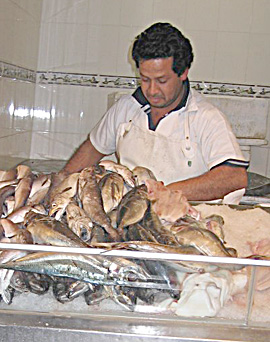 |
|
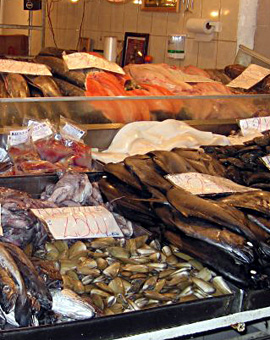 |
|
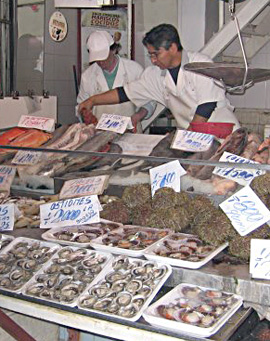 |
|
| |
Plenty of choices |
|
Everything's fishy |
|
Take your pick |
|
| |
|
|
|
|
|
|
| |
Satiated, I headed for Plaza de Armas, the downtown square, and returned to the Palacio de La Moneda, with a detour thrugh the Museo Historico Nacional. Back outside, I wandering through the plaza. My earlier visit was on a Sunday, when most of the central city was relatively quiet. Not this weekday. I walked past men playing serious games of chess, painters dabbing canvases propped on easels and, as everywhere in Santiago, more kissing and cooing couples. |
|
| |
|
|
| |
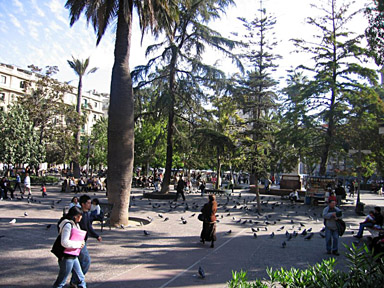 |
|
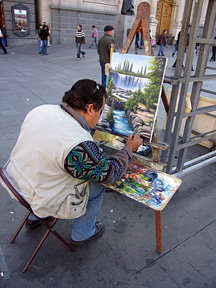 |
|
| |
Plaza strollers |
|
Painting the town |
|
| |
|
|
| |
Time was getting tight. I hurried back to the Hotel Plaza Londres. Before leaving, I checked my airline ticket, hoping I again had the wrong day. Darn. I wasn't lucky twice. |
|
|
|


